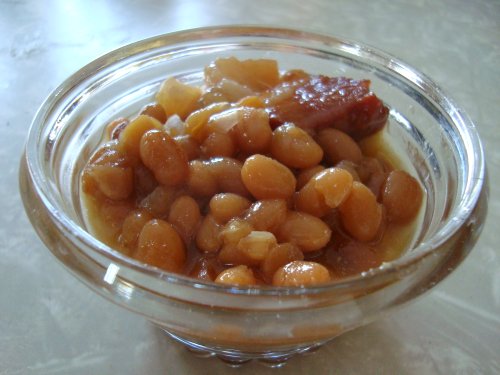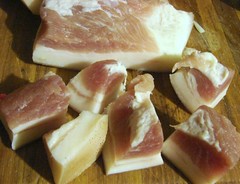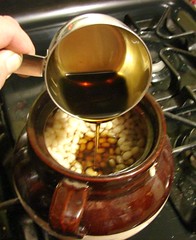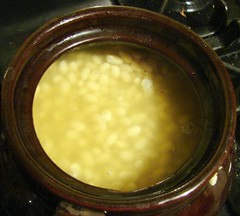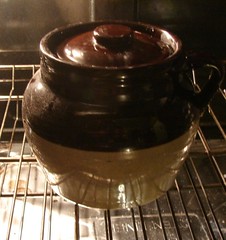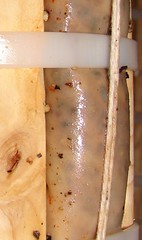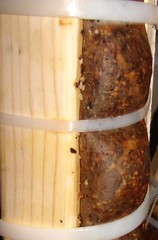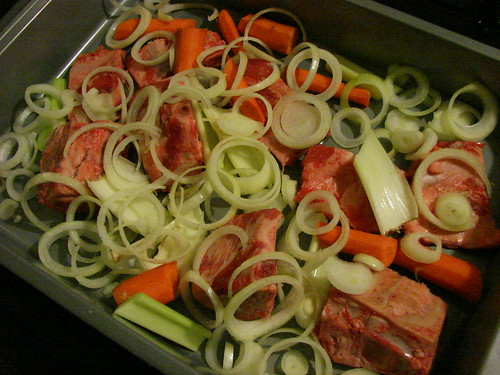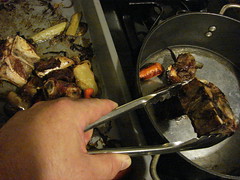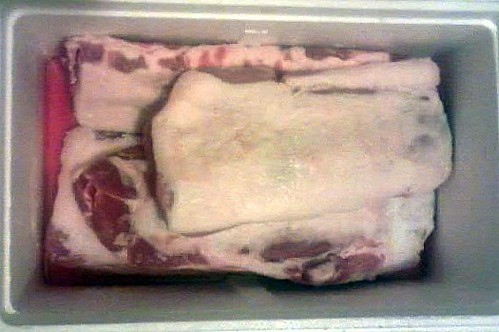When I first wrote about making capicola using the method Mike and Nina Massa taught me, I had no idea how much interest it would stir. I've received quite a few emails and blog comments, and I'd like to share them with you today.
Lou M in New Jersey wrote:
For 60 years, my father-in-law made his own meats. He always made them the same way they made them back in Italy when he was a kid. They killed the pig, and used every scrap of it. They made head cheese, blood pudding, fried skin, pickled pigs feet, and even made deviled ham out of the scraps. And they also made all the good stuff, like capicola, sausage, pepperoni, bacon, ribs, sopressata, etc.
My father-in-law just passed away a couple months ago. Fortunately, before he went, I recorded him making the meats, so as to assure the tradition would not be lost to history. So this year, we made the meats in his honor, albeit a scaled down version. Since my mother-in-law is still around, she knew how it was done, so it didn't come out half bad.
The one step we do different than you is to smoke the meats. . . I admit, smoking is half art and half science, and I still haven't mastered is as well as my father-in-law, but I'm getting better.
I salt the loins, put them in a clean covered crock and leave them in my cool enclosed porch for about 6 days. Then I pour wine over them, and leave them to soak for another day. Then I roll them in coarse pepper, shove them in the casings, put them in elastic netting, tie them up for good measure, and put them in the smoke house the same day. I also roll a couple in cayenne pepper for hot capicola. I don't use slats, although my father-in-law said he used to do it that way a long time ago. Between the strings and the netting, they keep their shape well enough. The problem with the slats is that you have to be careful that the meat immediately right behind the slats may not dry out well enough.I have a barbecue grill with the legs cut off at the bottom of the smoke house. I put about a dozen charcoal briquettes, a little kindling and a couple logs in there. The idea is you don't want a lot of smoke, just a little bit. And you want just a little heat; enough so the meats won't freeze. I light the fire and put the meats in first thing in the morning, then I add a little more wood every few hours. No roaring fire, hot coals are better. At night time I bring the meats back inside the porch so they don't freeze. Otherwise I'd have to get up in the middle of the night to stoke the fire. I remember my father-in-law said if it's not going to freeze during the night, he'll just throw some more briquettes on the fire and leave the meats in there over night.
I smoke them for about three days, then cure them for about three months in my porch. My father-in-law used to cure them in his basement. He said that back in Italy they just had them hanging in the kitchen. I don't think that would work in a hot American house.It takes some experimenting to get it right. If you have too much smoke, it ends up tasting like Lebanon bologna. And if there's too much heat, they dry up too much. But when it's done right, you'll think you died and went to Heaven when you eat them.
 Another trick Lou shared was an easier way of getting the pork into the casings: He stretches the casings over a PVC tube, then slides the meat through the tube and into the casing. Mike had done much the same thing one year, using a 2-liter soda bottle with the ends cut off.
Another trick Lou shared was an easier way of getting the pork into the casings: He stretches the casings over a PVC tube, then slides the meat through the tube and into the casing. Mike had done much the same thing one year, using a 2-liter soda bottle with the ends cut off.When Nina heard about Lou's method of smoking the capicola before aging it, she was horrified! "Smoke! That's not how you make capicola!" she said. But if there's one thing I've learned about chaucuterie over the past few years, it's that there is always more ways than one to make meat. Next season, you can bet that my smokehouse is going to have a few capicola hanging in it.
A few days ago, Tony in Ontario left a comment on the Seasoning and Casing The Pork blog entry:
My Father, as far as I can remember back never made anything but sausages. You know sausage is made one way and capicola a complete different way.
Ok, So as I got older I decided to take on the sausage as well with my Brothers and Sister. This is fine and is working out to this day. I tried a capicola long time ago, lets say I was the only one who seen the beauty in that. Was almost sure that I was the only one eating it also. . . that was then and this is now. With some guidance from a couple of close friends, and your website I too took on the challenge.

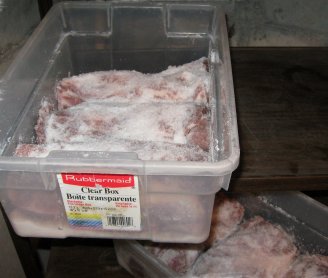
Above left: Tony and his friend Byron prepare the pork butts for salting. Above right: The salted pork is set aside in tubs for the initial cure.
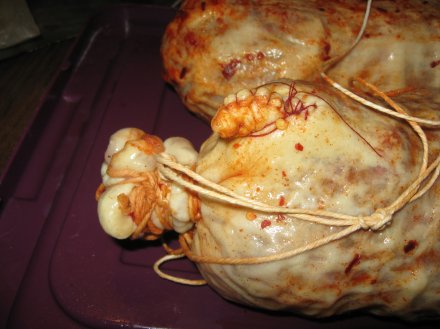 In my original post, I noted that even though the casing is fairly tough and will stretch quite a bit as they're stuffed, they can still tear if you aren't careful. For small holes, Mike would take a small scrap of casing left over from trimming the excess and tuck it behind the hole like patching an inner tube. As the capicola ages and the casing shrinks, the hole is sealed up pretty well.
In my original post, I noted that even though the casing is fairly tough and will stretch quite a bit as they're stuffed, they can still tear if you aren't careful. For small holes, Mike would take a small scrap of casing left over from trimming the excess and tuck it behind the hole like patching an inner tube. As the capicola ages and the casing shrinks, the hole is sealed up pretty well.Tony found a different way to deal with holes, including the natural hole found on the side of the casing near the open end. He just took a needle and thread and stitched them up - a great idea that is so obvious that I slapped myself for not thinking of it on my own:
Now when somethng happens or you need to close that little hole towards the top of the casing. I used a needle and thread and sewed them up, It worked great. By now you've became very familar with them so this shouldn't be too gross now...lol.
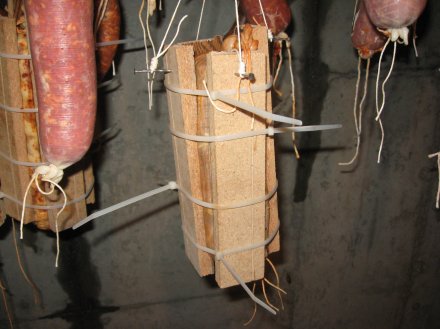 Tony also came up with a cool way to hang his cappy without having to worry about the butcher's string coming loose as the capicola shrinks - notice the nails sticking out of the top of the slats? Good idea. (For mine, I took my friend Roger's advice and drilled holes in the slats, then made wire hangers from old coathangers to suspend the capicola.)
Tony also came up with a cool way to hang his cappy without having to worry about the butcher's string coming loose as the capicola shrinks - notice the nails sticking out of the top of the slats? Good idea. (For mine, I took my friend Roger's advice and drilled holes in the slats, then made wire hangers from old coathangers to suspend the capicola.)Thank you to everyone who has emailed or left a comment for me here in the Cupboard. If you're making your own capicola this season - or any other kind of preserved meat, for that matter - I'd love to hear from you, too. My email address is in my profile, and feel free to include photos if you want - Gmail is pretty generous with attachments.
To Lou and Tony, my thanks for your permission to reprint your pictures and emails.
To Lou and Tony, my thanks for your permission to reprint your pictures and emails.
.

